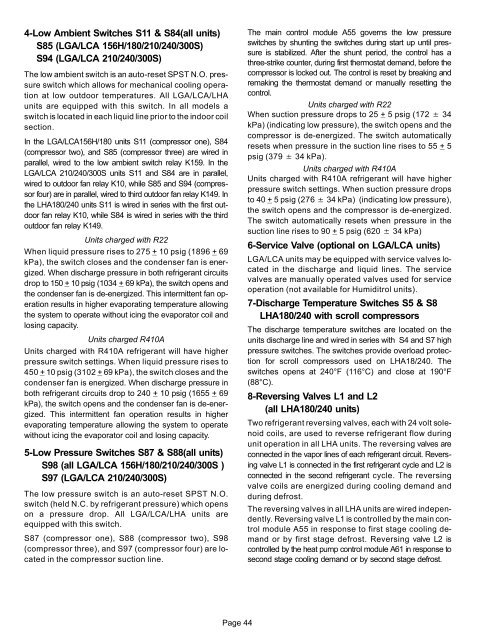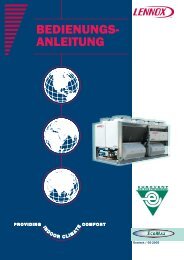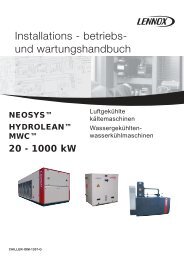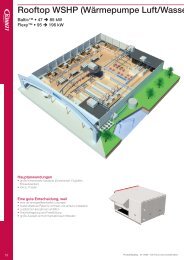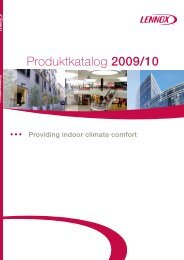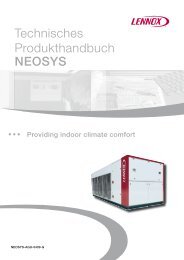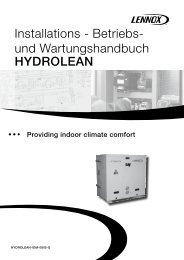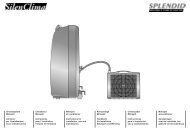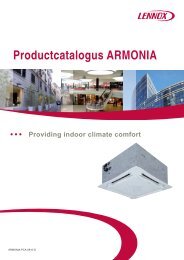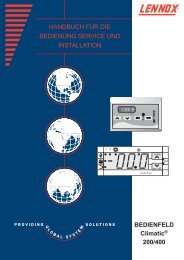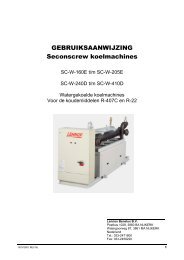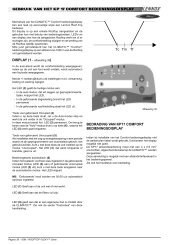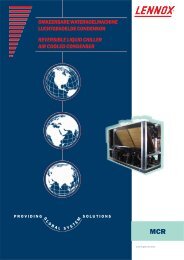LGA/LCA/LHA - lennox
LGA/LCA/LHA - lennox
LGA/LCA/LHA - lennox
You also want an ePaper? Increase the reach of your titles
YUMPU automatically turns print PDFs into web optimized ePapers that Google loves.
4−Low Ambient Switches S11 & S84(all units)<br />
S85 (<strong>LGA</strong>/<strong>LCA</strong> 156H/180/210/240/300S)<br />
S94 (<strong>LGA</strong>/<strong>LCA</strong> 210/240/300S)<br />
The low ambient switch is an auto-reset SPST N.O. pressure<br />
switch which allows for mechanical cooling operation<br />
at low outdoor temperatures. All <strong>LGA</strong>/<strong>LCA</strong>/<strong>LHA</strong><br />
units are equipped with this switch. In all models a<br />
switch is located in each liquid line prior to the indoor coil<br />
section.<br />
In the <strong>LGA</strong>/<strong>LCA</strong>156H/180 units S11 (compressor one), S84<br />
(compressor two), and S85 (compressor three) are wired in<br />
parallel, wired to the low ambient switch relay K159. In the<br />
<strong>LGA</strong>/<strong>LCA</strong> 210/240/300S units S11 and S84 are in parallel,<br />
wired to outdoor fan relay K10, while S85 and S94 (compressor<br />
four) are in parallel, wired to third outdoor fan relay K149. In<br />
the <strong>LHA</strong>180/240 units S11 is wired in series with the first outdoor<br />
fan relay K10, while S84 is wired in series with the third<br />
outdoor fan relay K149.<br />
Units charged with R22<br />
When liquid pressure rises to 275 + 10 psig (1896 + 69<br />
kPa), the switch closes and the condenser fan is energized.<br />
When discharge pressure in both refrigerant circuits<br />
drop to 150 + 10 psig (1034 + 69 kPa), the switch opens and<br />
the condenser fan is de−energized. This intermittent fan operation<br />
results in higher evaporating temperature allowing<br />
the system to operate without icing the evaporator coil and<br />
losing capacity.<br />
Units charged R410A<br />
Units charged with R410A refrigerant will have higher<br />
pressure switch settings. When liquid pressure rises to<br />
450 + 10 psig (3102 + 69 kPa), the switch closes and the<br />
condenser fan is energized. When discharge pressure in<br />
both refrigerant circuits drop to 240 + 10 psig (1655 + 69<br />
kPa), the switch opens and the condenser fan is de−energized.<br />
This intermittent fan operation results in higher<br />
evaporating temperature allowing the system to operate<br />
without icing the evaporator coil and losing capacity.<br />
5−Low Pressure Switches S87 & S88(all units)<br />
S98 (all <strong>LGA</strong>/<strong>LCA</strong> 156H/180/210/240/300S )<br />
S97 (<strong>LGA</strong>/<strong>LCA</strong> 210/240/300S)<br />
The low pressure switch is an auto-reset SPST N.O.<br />
switch (held N.C. by refrigerant pressure) which opens<br />
on a pressure drop. All <strong>LGA</strong>/<strong>LCA</strong>/<strong>LHA</strong> units are<br />
equipped with this switch.<br />
S87 (compressor one), S88 (compressor two), S98<br />
(compressor three), and S97 (compressor four) are located<br />
in the compressor suction line.<br />
Page 44<br />
The main control module A55 governs the low pressure<br />
switches by shunting the switches during start up until pressure<br />
is stabilized. After the shunt period, the control has a<br />
three-strike counter, during first thermostat demand, before the<br />
compressor is locked out. The control is reset by breaking and<br />
remaking the thermostat demand or manually resetting the<br />
control.<br />
Units charged with R22<br />
When suction pressure drops to 25 + 5 psig (172 � 34<br />
kPa) (indicating low pressure), the switch opens and the<br />
compressor is de−energized. The switch automatically<br />
resets when pressure in the suction line rises to 55 + 5<br />
psig (379 � 34 kPa).<br />
Units charged with R410A<br />
Units charged with R410A refrigerant will have higher<br />
pressure switch settings. When suction pressure drops<br />
to 40 + 5 psig (276 � 34 kPa) (indicating low pressure),<br />
the switch opens and the compressor is de−energized.<br />
The switch automatically resets when pressure in the<br />
suction line rises to 90 + 5 psig (620 � 34 kPa)<br />
6−Service Valve (optional on <strong>LGA</strong>/<strong>LCA</strong> units)<br />
<strong>LGA</strong>/<strong>LCA</strong> units may be equipped with service valves located<br />
in the discharge and liquid lines. The service<br />
valves are manually operated valves used for service<br />
operation (not available for Humiditrol units).<br />
7−Discharge Temperature Switches S5 & S8<br />
<strong>LHA</strong>180/240 with scroll compressors<br />
The discharge temperature switches are located on the<br />
units discharge line and wired in series with S4 and S7 high<br />
pressure switches. The switches provide overload protection<br />
for scroll compressors used on <strong>LHA</strong>18/240. The<br />
switches opens at 240°F (116°C) and close at 190°F<br />
(88°C).<br />
8−Reversing Valves L1 and L2<br />
(all <strong>LHA</strong>180/240 units)<br />
Two refrigerant reversing valves, each with 24 volt solenoid<br />
coils, are used to reverse refrigerant flow during<br />
unit operation in all <strong>LHA</strong> units. The reversing valves are<br />
connected in the vapor lines of each refrigerant circuit. Reversing<br />
valve L1 is connected in the first refrigerant cycle and L2 is<br />
connected in the second refrigerant cycle. The reversing<br />
valve coils are energized during cooling demand and<br />
during defrost.<br />
The reversing valves in all <strong>LHA</strong> units are wired independently.<br />
Reversing valve L1 is controlled by the main control<br />
module A55 in response to first stage cooling demand<br />
or by first stage defrost. Reversing valve L2 is<br />
controlled by the heat pump control module A61 in response to<br />
second stage cooling demand or by second stage defrost.


